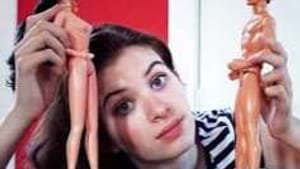Stay in the Loop
BSR publishes on a weekly schedule, with an email newsletter every Wednesday and Thursday morning. There’s no paywall, and subscribing is always free.
A modern Nora, or just a confused one?
‘A Doll’s House’: the Geffers adaptation (2nd review)

I taught a course in Women’s Films for many years, and Ibsen’s A Doll’s House never made the cut. Although it’s seen as an early statement of feminism— one version even starred Jane Fonda!— it failed to meet the criteria I had set for the class: films written and directed by women. So I was excited and curious to see what a woman had done with this classic story of a woman’s recognition that she had a right to speak in her own voice, without manipulating a man through childishness and sexuality.
I left EgoPo’s presentation with many questions. I would so love to sit down with its creator, Brenna Geffers, and ask her why she made some of the choices she made. What statement was she really trying to make?
The play was set in a young girl's playroom, with dolls, and magazines scattered about. A table and a bookcase served as locations, a trunk held the dolls not in play, a cheval mirror doubled as a malevolent Darth Vader, and an iPad offered voices and music for the actress to interact with.
Tea party
Mackenzie Maula’s performance— not only as Nora but voicing most of the other characters as well— was stunning. Nora is a difficult role even for a seasoned performer, and this 14-year-old actress did a fantastic job of being both childlike in her doll play and mature in her performance of Ibsen’s updated lines.
Yet sometimes I felt I was watching those E-trade babies, speaking as adults as they sit in their highchairs and flail about like the infants they are. Maula maintained her sense of youthfulness throughout, expressing her distaste for a lecherous men and her enjoyment of the simple pleasure of a tea party with her dolls, yet I wasn’t always comfortable with the results.
The text was Ibsen— truncated and amended to fit the time and the times— but still true to the original. It worked at first, with Ken and Barbie dolls as Nora and Torvald. The lines sounded odd when spoken in the actress’s childish voice, but Nora in the original was very much a child.
Tank top and shorts
Then the performer switched to other dolls, dressed as she was dressed. This device suggested that the performer and the dolls were one. When it came to voicing other characters, a touch of the hand, a change of voice and Raggedy Ann became the maid, a martini glass and tie became Torvald.
And then, just as the villainous Krogstad was about to appear, Nora stripped down to tank top and shorts with a shimmery scarf, put on bright red lipstick and began preening in the mirror— an interesting and uncomfortable choice.
I didn’t think of Nora as a sexual creature, yet this version hinted, for those who didn’t know the story, that she might have sold her body for the money to save her husband rather than having committed a much more mundane white-collar crime. It also suggested that sex was part of the equation with Krogstad.
Men and money
Was this hint of sex, with the enactment of violence at the end, an attempt to update Ibsen’s original? But in that case, why cast a 14-year-old in the role? Wouldn’t it have been more powerful to have a mature actress in the playroom, looking back on her adolescence? And why convert the psychological subjugation of women through threats, money, and manipulation to physical acts of abuse?
I walked out of the theater both impressed and disturbed. What had I learned about Ibsen and feminism from this performance? What would a 14-year-old girl have learned about growing up in a world dominated by men and money?
According to recent survey, women still don’t earn as much as men, so maybe our world hasn’t changed from Ibsen’s all that much, and women still need to learn how to stand on their own.
The play ends with Nora declaring, “I believe we can change.” But her voice is drowned out by a cacophony of voices and sounds emanating from her iPad. Maybe things haven’t changed after all. Maybe we women remain the equivalent of 14-year-olds playing dress-up in our playrooms— playrooms created for us in a world that remains beyond our control.
We still want to believe we can change. But can we?♦
To read another review by Steve Cohen, click here.
I left EgoPo’s presentation with many questions. I would so love to sit down with its creator, Brenna Geffers, and ask her why she made some of the choices she made. What statement was she really trying to make?
The play was set in a young girl's playroom, with dolls, and magazines scattered about. A table and a bookcase served as locations, a trunk held the dolls not in play, a cheval mirror doubled as a malevolent Darth Vader, and an iPad offered voices and music for the actress to interact with.
Tea party
Mackenzie Maula’s performance— not only as Nora but voicing most of the other characters as well— was stunning. Nora is a difficult role even for a seasoned performer, and this 14-year-old actress did a fantastic job of being both childlike in her doll play and mature in her performance of Ibsen’s updated lines.
Yet sometimes I felt I was watching those E-trade babies, speaking as adults as they sit in their highchairs and flail about like the infants they are. Maula maintained her sense of youthfulness throughout, expressing her distaste for a lecherous men and her enjoyment of the simple pleasure of a tea party with her dolls, yet I wasn’t always comfortable with the results.
The text was Ibsen— truncated and amended to fit the time and the times— but still true to the original. It worked at first, with Ken and Barbie dolls as Nora and Torvald. The lines sounded odd when spoken in the actress’s childish voice, but Nora in the original was very much a child.
Tank top and shorts
Then the performer switched to other dolls, dressed as she was dressed. This device suggested that the performer and the dolls were one. When it came to voicing other characters, a touch of the hand, a change of voice and Raggedy Ann became the maid, a martini glass and tie became Torvald.
And then, just as the villainous Krogstad was about to appear, Nora stripped down to tank top and shorts with a shimmery scarf, put on bright red lipstick and began preening in the mirror— an interesting and uncomfortable choice.
I didn’t think of Nora as a sexual creature, yet this version hinted, for those who didn’t know the story, that she might have sold her body for the money to save her husband rather than having committed a much more mundane white-collar crime. It also suggested that sex was part of the equation with Krogstad.
Men and money
Was this hint of sex, with the enactment of violence at the end, an attempt to update Ibsen’s original? But in that case, why cast a 14-year-old in the role? Wouldn’t it have been more powerful to have a mature actress in the playroom, looking back on her adolescence? And why convert the psychological subjugation of women through threats, money, and manipulation to physical acts of abuse?
I walked out of the theater both impressed and disturbed. What had I learned about Ibsen and feminism from this performance? What would a 14-year-old girl have learned about growing up in a world dominated by men and money?
According to recent survey, women still don’t earn as much as men, so maybe our world hasn’t changed from Ibsen’s all that much, and women still need to learn how to stand on their own.
The play ends with Nora declaring, “I believe we can change.” But her voice is drowned out by a cacophony of voices and sounds emanating from her iPad. Maybe things haven’t changed after all. Maybe we women remain the equivalent of 14-year-olds playing dress-up in our playrooms— playrooms created for us in a world that remains beyond our control.
We still want to believe we can change. But can we?♦
To read another review by Steve Cohen, click here.
What, When, Where
A Doll’s House. Adapted by Brenna Geffers, from the play by Henrik Ibsen; Geffers directed. An EgoPo Classic Theater production for FringeArts Festival through September 22, 2013, at the Adrienne, 2030 Sansom St. (267) 273-1414 or egopo.org or fringearts.ticketleap.com.
Sign up for our newsletter
All of the week's new articles, all in one place. Sign up for the free weekly BSR newsletters, and don't miss a conversation.

 Naomi Orwin
Naomi Orwin